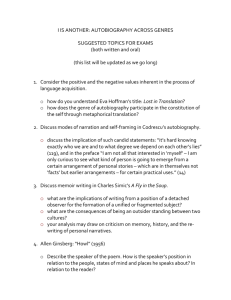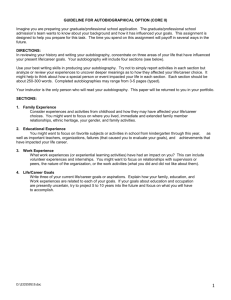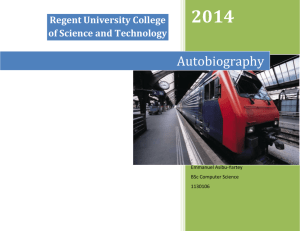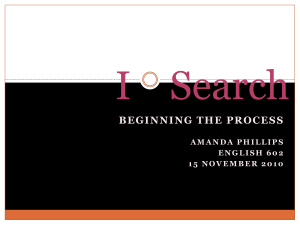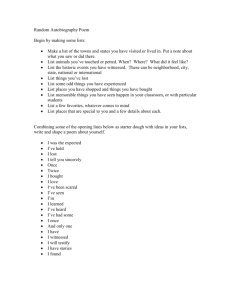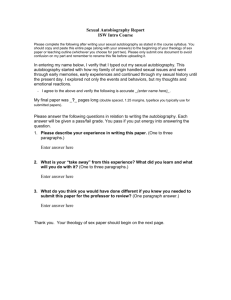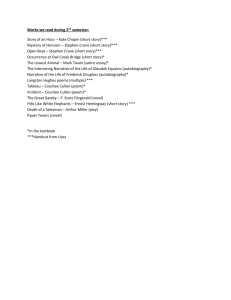Genre
advertisement
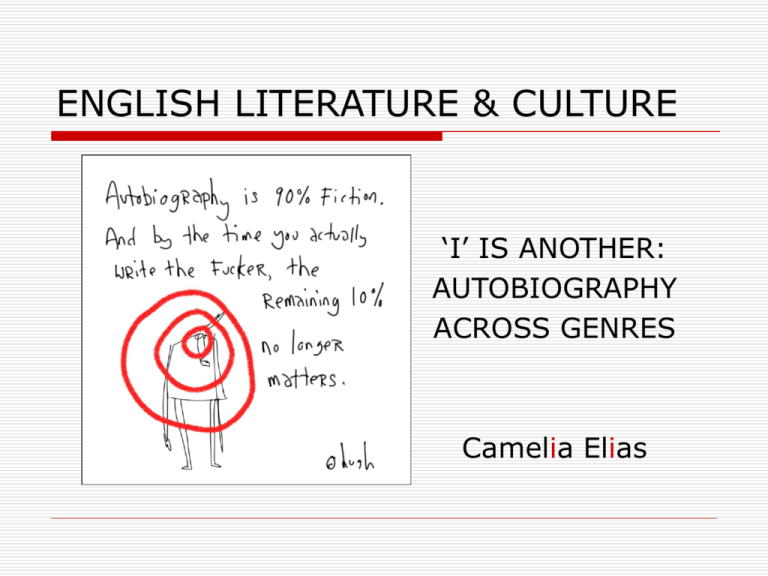
ENGLISH LITERATURE & CULTURE ‘I’ IS ANOTHER: AUTOBIOGRAPHY ACROSS GENRES Camelia Elias between sociology and autobiography • the collective self/the collective in the self • • • (Malcolm X) sociology: descriptions of interactions autobiography: self-definition of actions autobiographical performance a move from autobiography as a literary event to autobiography as a social injunction as a social injunction autobiography follows a heuristic model (it teaches, or instructs, it provides a role model) social/private aims • “in the act of providing meaning and unity to a private life, the autobiographer seeks to impart meaning and unity to the social order” (Irving Horowitz, 174) transcendence and immortality • • the autobiographer’s need beyond moral injunction and role emulation: to transcend to achieving immortality to reach beyond the individual state, nature, society to create a ‘generalized other’ the task of autobiography: to point to what is common to us all to demonstrate that each one of the selves is different than the other to show that we cannot fulfill ourselves unless we are members of a group in whom there’s a community of attitudes autobiographical authorizations • autobiography serves to fill the void for • generalized others as well as for particularized selves (Horowitz) strategic moves: from autobiography as moral instruction to personal transcendence to social ideology divine/historical immortality • autobiography as biography: objectivity anonymity autobiography vs. social discourse • autobiography is not a fit subject for social • • • examination self-examination is akin to self-celebration some performers are outstanding because they know how to perform, not because they are honest if the autobiography is good, it has to involve unusual people (who are hard to emulate) autobiography as an act of writing • ‘painful’ endeavor from combining self-reflection with the • • constraints of genre celebratory endeavor the ‘other’ is as important as the ‘self’ autobiography under the generational sign – The Beats • The Beats were almost uniformly opposed to being categorized. • Most of them refused to be associated with the Beat Generation at one point or another. • Despite this resistance to being “put in a box”, there are common themes and subject matter in their writing. themes • • • • • • spontaneity, to the point of chaos rejection of “square” or conservative/conventional society non-conformity in general, both in content and style open, uncensored emotion gritty subject material, often up close and personal, viewed as shocking and/or offensive by square society. the Beats were hugely culturally influential and incredibly innovative and courageous in their literary style and content. Jack Kerouac (1922-1969) • was born Jean-Louis Kerouac. • His parents were French Canadian, and consequently young Jack learned English as second language. • only attended college briefly, and also enlisted in the U.S. Navy. He was, however, discharged as a schizoid personality • attended Columbia University in NYC On the Road • After being discharged from the Navy, Jack roamed the United States and Mexico, by car and bus when possible, but also by hitchhiking and as an illegal passenger on trains. • It was these experiences, as well as a friendship with Neal Cassady that would provide the material for his most famous novel, On The Road. • Though he completed On The Road in two drug and coffee fueled weeks in 1948, it would not be published until 1957. Kerouac’s style • • • free-flowing stream of consciousness “spontaneous prose”. based around the theory of ‘first thought, best thought’ because of this philosophy, Kerouac rarely edited his work Kerouac’s writing “commandments” 1. Scribbled secret notebooks, and wild typewritten pages, for yr own joy 2. Submissive to everything, open, listening 3. Try never get drunk outside your own house 4. Be in love with your life 5. Something that you feel will find its own form 6. Be crazy dumbsaint of the mind On the Road • • • • • written on scroll form follows content the content is the condition for the possibility of form agenda for analysis Basic Hip – Kerouac times narration/stylistics Narration • 1st person point of view (limited) • Involved narrator • Narrative irony? • Reliability? • Epiphanies? Stylistics/Diction • Repetitions/riffs/ "mantras” • Enumeration • Compounds • Unusual predicates thematics/themes Thematics • 'Blow’ • 'Hip’ • 'IT’ • 'Dig’ • 'Go'/'Gone’ • 'Knowing time’ • 'Beat'/'beaten'/Beatific • Oysters/pearls • Food/eating • Falling apart/collapsing Themes • Memory/experience /writing • Talk/language/lingo • Madness/insight/visions • Music/God • Questing/finding • Sex & love/Male bonding • Weltschmerz • Identity/community genre/contexts Genre Contexts • Autobiography, • Generationality/Bilconfession dungsroman/Bohemianism • Novel • Intertextuality/Paro• Travelogue dy/Elegiac romance • Manifesto/document • Cult status/imitation Allen Ginsberg 1926-1997 His family life was tumultuous, and would leave a lasting impression in his work. Ginsberg’s father was a Jewish socialist and teacher, and his mother was a radical Communist who would eventually go completely insane. She would go on to be institutionalized, and in keeping with medical practices of the day, she was lobotomized. His mother’s condition haunted Allen, and manifested itself in one of his finest poems, “Kaddish”. straight or queer/mad or normal • Ginsberg went through an early phase after studying at • • Columbia U where he attempted “square” life. He went to a psychiatric institution to help “fix” himself. There, he met Carl Solomon who would be the inspiration for “Howl”, Ginsberg’s most famous poem. City Lights, the bookstore from which “Howl” was confiscated. Howl • • • • • is generally considered the rallying cry of the alienated youth of Ginsberg’s generation. is specifically generational – written for a generation is a eulogy for a generation gone mad is an autobiographical and a coterie poem Ginsberg and the American Scream Obscenity trial for Howl • the poem deals very frankly • • • Hear Ginsberg on censorship. with drugs, sex, and the grittier side of city living. Because of its language and subject matter, customs officials seized all copies of it, which led to a 1957 obscenity trial. With the help of the American Civil Liberties Union, “Howl” was once again allowed to be sold. This landmark case set a precedent against censorship that has had a huge effect on the literature we are able to read today. Allen would go on to travel the world, and discover Buddhism for himself. Unlike the other Beats, Allen embraced the Hippie Movement. He heavily promoted the use of the hallucinogenic drug LSD, and was largely influential in 60s pop culture. during the Summer of Love Ginsberg and Kaddish • • • • • Dedicated to the poet's mother, Naomi Ginsberg a narration and a lament arising from Ginsberg's memories, three years after Naomi's death, of her life and of his life with her. the poem is subdivided into 5 sections that address the dead woman directly. The highly poetic Part I is a reflection on death life "all the accumulations of life, that wear us out" mortality: the link between the dead and the living the great unknown that lies beyond death – not in the abstract, but in the signs and symbols of Naomi's life/death and in the issues that remain for her son: "Now I've got to cut through – to talk to you / - as I didn't when you had a mouth." Bob Dylan’s 1978 docudrama Renaldo and Clara lyrical personae/stylistics/diction Lyrical personae • “I” and “my mother” • Omniscient/prophetic point of view • Specific second person addressee Naomi Stylistics/diction • Biblical metaphor • Direct address/apostrophe • Repetitious structures • Exclamation and declamation • Curses and blessings • Stream of consciousness • The long line (Whitman, the Torah) thematics/themes • Violence and • The individual vs. the • • • • • • • destruction Madness Quest for connection Institutions/mental hospital Travel and exile memory name the unnamable • • ghost/phantom Death/darkenss Struggle between madness and normalcy Questing/finding Holiness (kaddish) genre/contexts genre • Long poem • Unrhymed poetry • Base + variation (no more, toward) • Incantation • rhythmic chant • eulogy for the mother contexts • Autobiography • confession • Biblical (Jewish) intertextuality • Kaddish the magnification and sanctification of God's name. ritual of mourning Generation X autobiographies Douglas Coupland: Polaroids from the Dead • a collection of short stories • the theme is that each story is written from a collection of old polaroids Coupland found in a drawer. • the book describes the 1990s, a decade that "seemed to be living in a 1980s hangover". fragmentations • • topics include various stories ranging from commentaries on film to concerts, and famous people such as Marylyn Monroe and Kurt Cobain the book forms in part a collage of menus, scraps of conversation, and postings from bulletin boards. theme as generational genre • • • • history memory death personal confession in the names of… Harold and Maude / official website parents and children young and old generalized others and particularized selves Reality Bites (1994; dir. Ben Stiller) • • • Gen X autobiography about love in the 90s generation gaps are particularly articulated in the tension between materialism and idealism concerns: how are ideologies formed? what is the position of the self as an artist in relation to ideology? Helen Childress (screen writer) • "The film was so personal to me. It’s not like I researched anything. I honestly just wrote about myself and my experiences and my friends’ experiences. I actually lived off my Dad’s gas card for a couple months. It’s funny when people say it’s so commercial. God, my life is commercial?"
